HR303 Fundamentals of Training and Development
VerifiedAdded on 2021/09/30
|10
|1508
|84
AI Summary
Contribute Materials
Your contribution can guide someone’s learning journey. Share your
documents today.
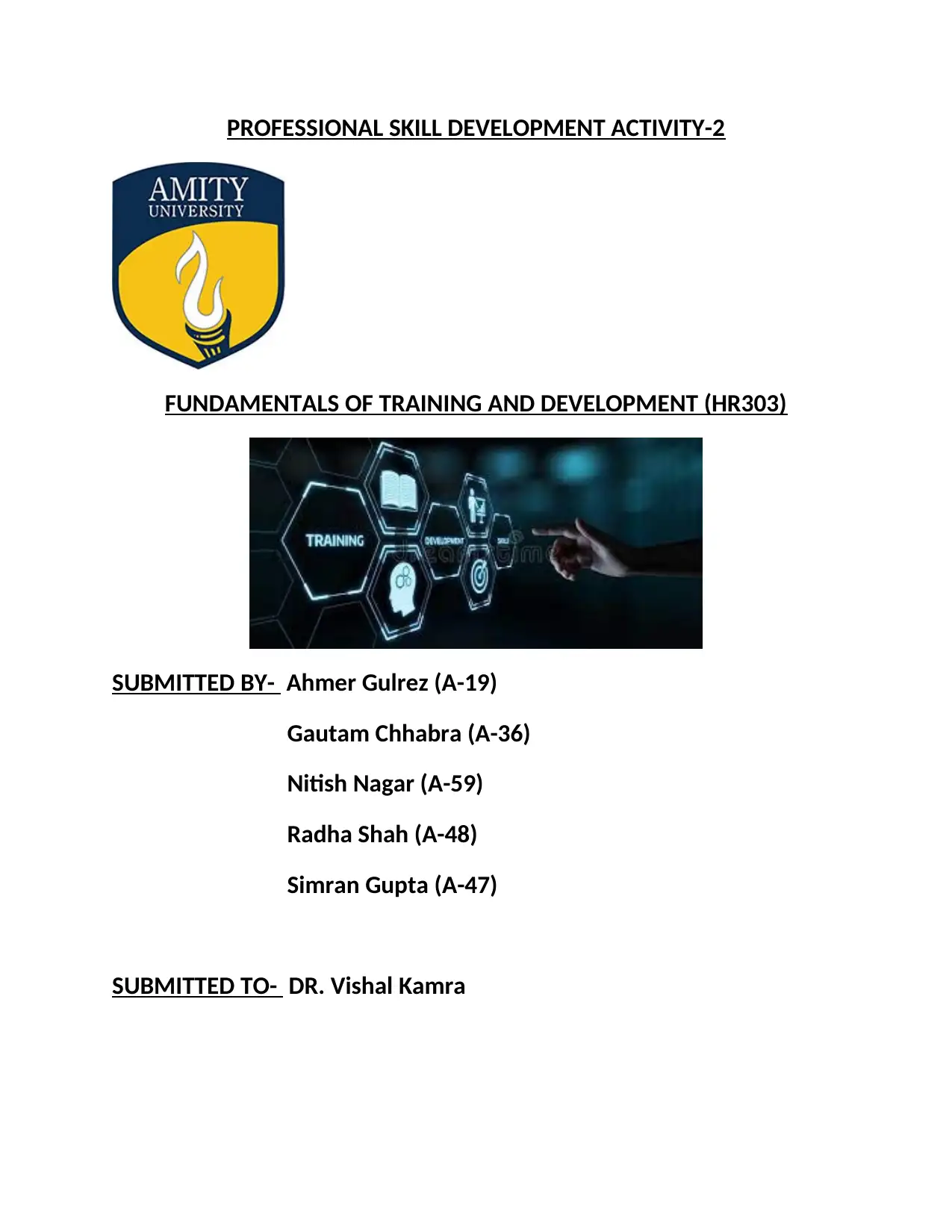
PROFESSIONAL SKILL DEVELOPMENT ACTIVITY-2
FUNDAMENTALS OF TRAINING AND DEVELOPMENT (HR303)
SUBMITTED BY- Ahmer Gulrez (A-19)
Gautam Chhabra (A-36)
Nitish Nagar (A-59)
Radha Shah (A-48)
Simran Gupta (A-47)
SUBMITTED TO- DR. Vishal Kamra
FUNDAMENTALS OF TRAINING AND DEVELOPMENT (HR303)
SUBMITTED BY- Ahmer Gulrez (A-19)
Gautam Chhabra (A-36)
Nitish Nagar (A-59)
Radha Shah (A-48)
Simran Gupta (A-47)
SUBMITTED TO- DR. Vishal Kamra
Secure Best Marks with AI Grader
Need help grading? Try our AI Grader for instant feedback on your assignments.
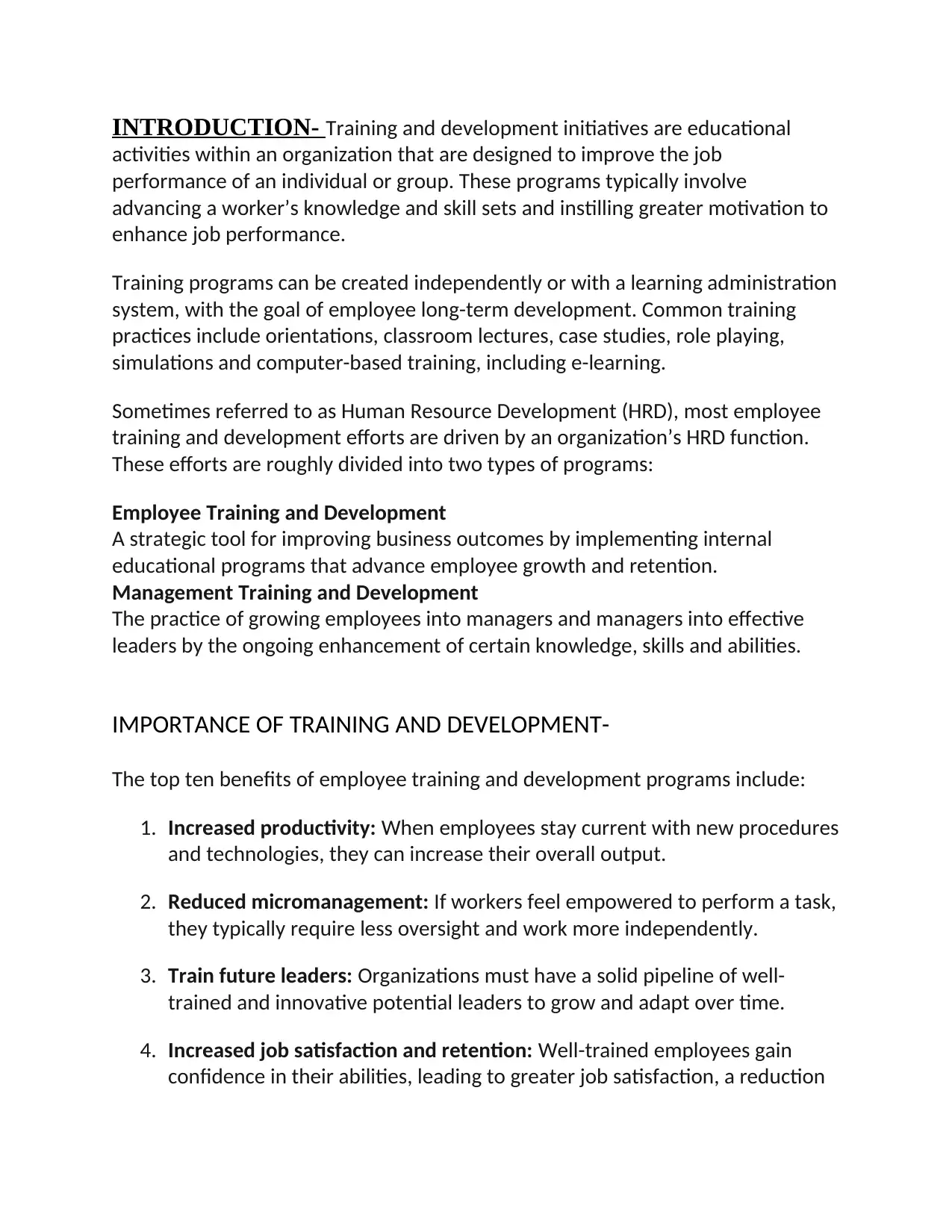
INTRODUCTION- Training and development initiatives are educational
activities within an organization that are designed to improve the job
performance of an individual or group. These programs typically involve
advancing a worker’s knowledge and skill sets and instilling greater motivation to
enhance job performance.
Training programs can be created independently or with a learning administration
system, with the goal of employee long-term development. Common training
practices include orientations, classroom lectures, case studies, role playing,
simulations and computer-based training, including e-learning.
Sometimes referred to as Human Resource Development (HRD), most employee
training and development efforts are driven by an organization’s HRD function.
These efforts are roughly divided into two types of programs:
Employee Training and Development
A strategic tool for improving business outcomes by implementing internal
educational programs that advance employee growth and retention.
Management Training and Development
The practice of growing employees into managers and managers into effective
leaders by the ongoing enhancement of certain knowledge, skills and abilities.
IMPORTANCE OF TRAINING AND DEVELOPMENT-
The top ten benefits of employee training and development programs include:
1. Increased productivity: When employees stay current with new procedures
and technologies, they can increase their overall output.
2. Reduced micromanagement: If workers feel empowered to perform a task,
they typically require less oversight and work more independently.
3. Train future leaders: Organizations must have a solid pipeline of well-
trained and innovative potential leaders to grow and adapt over time.
4. Increased job satisfaction and retention: Well-trained employees gain
confidence in their abilities, leading to greater job satisfaction, a reduction
activities within an organization that are designed to improve the job
performance of an individual or group. These programs typically involve
advancing a worker’s knowledge and skill sets and instilling greater motivation to
enhance job performance.
Training programs can be created independently or with a learning administration
system, with the goal of employee long-term development. Common training
practices include orientations, classroom lectures, case studies, role playing,
simulations and computer-based training, including e-learning.
Sometimes referred to as Human Resource Development (HRD), most employee
training and development efforts are driven by an organization’s HRD function.
These efforts are roughly divided into two types of programs:
Employee Training and Development
A strategic tool for improving business outcomes by implementing internal
educational programs that advance employee growth and retention.
Management Training and Development
The practice of growing employees into managers and managers into effective
leaders by the ongoing enhancement of certain knowledge, skills and abilities.
IMPORTANCE OF TRAINING AND DEVELOPMENT-
The top ten benefits of employee training and development programs include:
1. Increased productivity: When employees stay current with new procedures
and technologies, they can increase their overall output.
2. Reduced micromanagement: If workers feel empowered to perform a task,
they typically require less oversight and work more independently.
3. Train future leaders: Organizations must have a solid pipeline of well-
trained and innovative potential leaders to grow and adapt over time.
4. Increased job satisfaction and retention: Well-trained employees gain
confidence in their abilities, leading to greater job satisfaction, a reduction
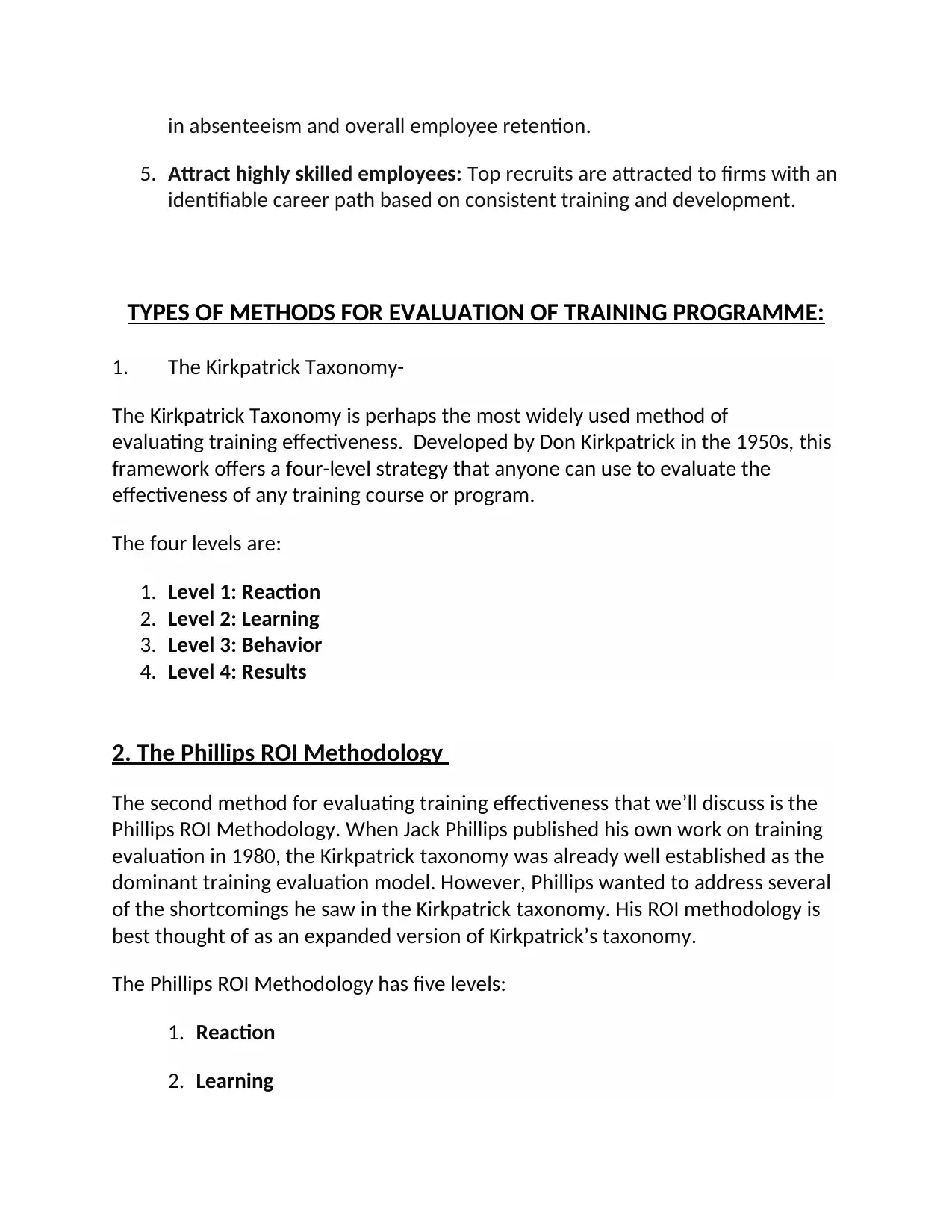
in absenteeism and overall employee retention.
5. Attract highly skilled employees: Top recruits are attracted to firms with an
identifiable career path based on consistent training and development.
TYPES OF METHODS FOR EVALUATION OF TRAINING PROGRAMME:
1. The Kirkpatrick Taxonomy-
The Kirkpatrick Taxonomy is perhaps the most widely used method of
evaluating training effectiveness. Developed by Don Kirkpatrick in the 1950s, this
framework offers a four-level strategy that anyone can use to evaluate the
effectiveness of any training course or program.
The four levels are:
1. Level 1: Reaction
2. Level 2: Learning
3. Level 3: Behavior
4. Level 4: Results
2. The Phillips ROI Methodology
The second method for evaluating training effectiveness that we’ll discuss is the
Phillips ROI Methodology. When Jack Phillips published his own work on training
evaluation in 1980, the Kirkpatrick taxonomy was already well established as the
dominant training evaluation model. However, Phillips wanted to address several
of the shortcomings he saw in the Kirkpatrick taxonomy. His ROI methodology is
best thought of as an expanded version of Kirkpatrick’s taxonomy.
The Phillips ROI Methodology has five levels:
1. Reaction
2. Learning
5. Attract highly skilled employees: Top recruits are attracted to firms with an
identifiable career path based on consistent training and development.
TYPES OF METHODS FOR EVALUATION OF TRAINING PROGRAMME:
1. The Kirkpatrick Taxonomy-
The Kirkpatrick Taxonomy is perhaps the most widely used method of
evaluating training effectiveness. Developed by Don Kirkpatrick in the 1950s, this
framework offers a four-level strategy that anyone can use to evaluate the
effectiveness of any training course or program.
The four levels are:
1. Level 1: Reaction
2. Level 2: Learning
3. Level 3: Behavior
4. Level 4: Results
2. The Phillips ROI Methodology
The second method for evaluating training effectiveness that we’ll discuss is the
Phillips ROI Methodology. When Jack Phillips published his own work on training
evaluation in 1980, the Kirkpatrick taxonomy was already well established as the
dominant training evaluation model. However, Phillips wanted to address several
of the shortcomings he saw in the Kirkpatrick taxonomy. His ROI methodology is
best thought of as an expanded version of Kirkpatrick’s taxonomy.
The Phillips ROI Methodology has five levels:
1. Reaction
2. Learning
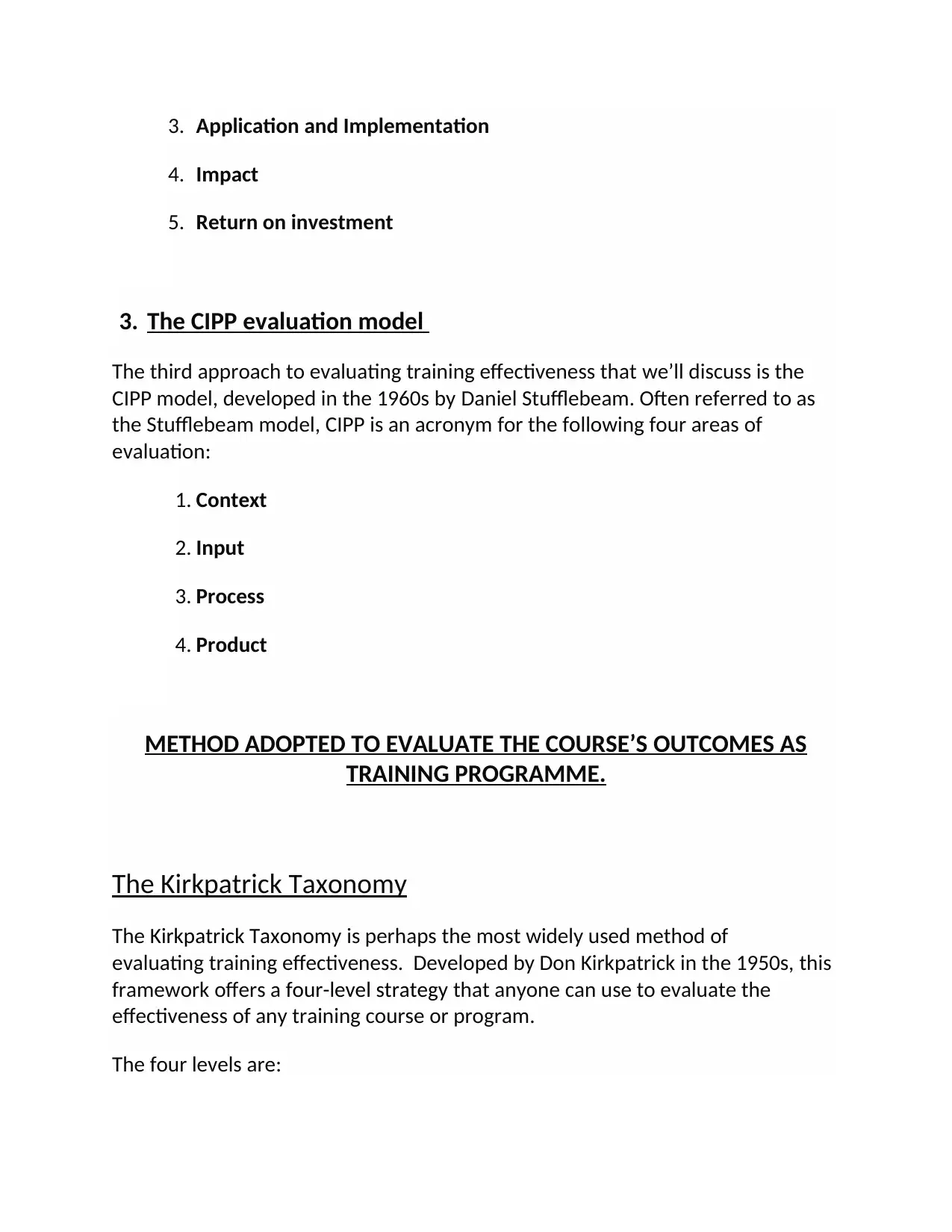
3. Application and Implementation
4. Impact
5. Return on investment
3. The CIPP evaluation model
The third approach to evaluating training effectiveness that we’ll discuss is the
CIPP model, developed in the 1960s by Daniel Stufflebeam. Often referred to as
the Stufflebeam model, CIPP is an acronym for the following four areas of
evaluation:
1. Context
2. Input
3. Process
4. Product
METHOD ADOPTED TO EVALUATE THE COURSE’S OUTCOMES AS
TRAINING PROGRAMME.
The Kirkpatrick Taxonomy
The Kirkpatrick Taxonomy is perhaps the most widely used method of
evaluating training effectiveness. Developed by Don Kirkpatrick in the 1950s, this
framework offers a four-level strategy that anyone can use to evaluate the
effectiveness of any training course or program.
The four levels are:
4. Impact
5. Return on investment
3. The CIPP evaluation model
The third approach to evaluating training effectiveness that we’ll discuss is the
CIPP model, developed in the 1960s by Daniel Stufflebeam. Often referred to as
the Stufflebeam model, CIPP is an acronym for the following four areas of
evaluation:
1. Context
2. Input
3. Process
4. Product
METHOD ADOPTED TO EVALUATE THE COURSE’S OUTCOMES AS
TRAINING PROGRAMME.
The Kirkpatrick Taxonomy
The Kirkpatrick Taxonomy is perhaps the most widely used method of
evaluating training effectiveness. Developed by Don Kirkpatrick in the 1950s, this
framework offers a four-level strategy that anyone can use to evaluate the
effectiveness of any training course or program.
The four levels are:
Secure Best Marks with AI Grader
Need help grading? Try our AI Grader for instant feedback on your assignments.
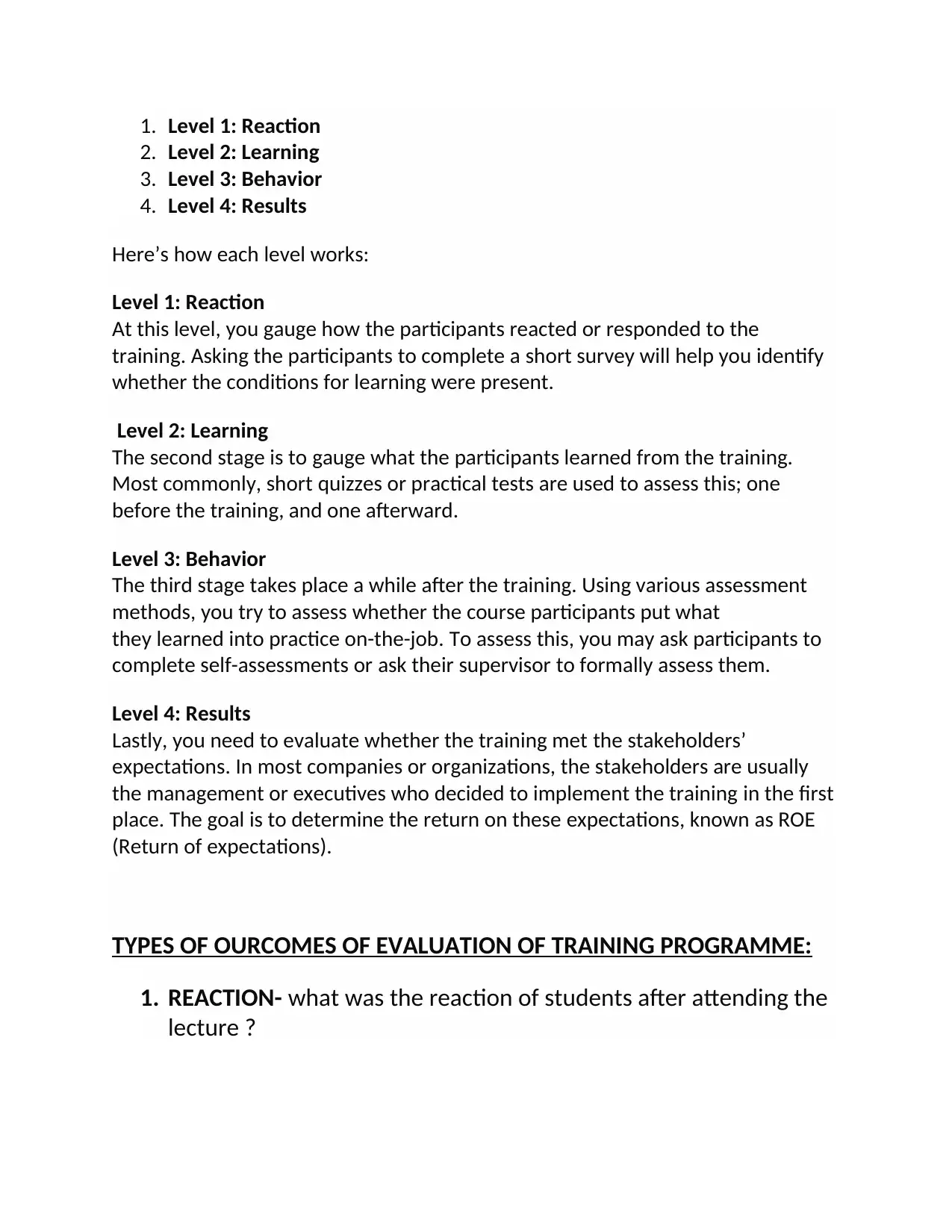
1. Level 1: Reaction
2. Level 2: Learning
3. Level 3: Behavior
4. Level 4: Results
Here’s how each level works:
Level 1: Reaction
At this level, you gauge how the participants reacted or responded to the
training. Asking the participants to complete a short survey will help you identify
whether the conditions for learning were present.
Level 2: Learning
The second stage is to gauge what the participants learned from the training.
Most commonly, short quizzes or practical tests are used to assess this; one
before the training, and one afterward.
Level 3: Behavior
The third stage takes place a while after the training. Using various assessment
methods, you try to assess whether the course participants put what
they learned into practice on-the-job. To assess this, you may ask participants to
complete self-assessments or ask their supervisor to formally assess them.
Level 4: Results
Lastly, you need to evaluate whether the training met the stakeholders’
expectations. In most companies or organizations, the stakeholders are usually
the management or executives who decided to implement the training in the first
place. The goal is to determine the return on these expectations, known as ROE
(Return of expectations).
TYPES OF OURCOMES OF EVALUATION OF TRAINING PROGRAMME:
1. REACTION- what was the reaction of students after attending the
lecture ?
2. Level 2: Learning
3. Level 3: Behavior
4. Level 4: Results
Here’s how each level works:
Level 1: Reaction
At this level, you gauge how the participants reacted or responded to the
training. Asking the participants to complete a short survey will help you identify
whether the conditions for learning were present.
Level 2: Learning
The second stage is to gauge what the participants learned from the training.
Most commonly, short quizzes or practical tests are used to assess this; one
before the training, and one afterward.
Level 3: Behavior
The third stage takes place a while after the training. Using various assessment
methods, you try to assess whether the course participants put what
they learned into practice on-the-job. To assess this, you may ask participants to
complete self-assessments or ask their supervisor to formally assess them.
Level 4: Results
Lastly, you need to evaluate whether the training met the stakeholders’
expectations. In most companies or organizations, the stakeholders are usually
the management or executives who decided to implement the training in the first
place. The goal is to determine the return on these expectations, known as ROE
(Return of expectations).
TYPES OF OURCOMES OF EVALUATION OF TRAINING PROGRAMME:
1. REACTION- what was the reaction of students after attending the
lecture ?
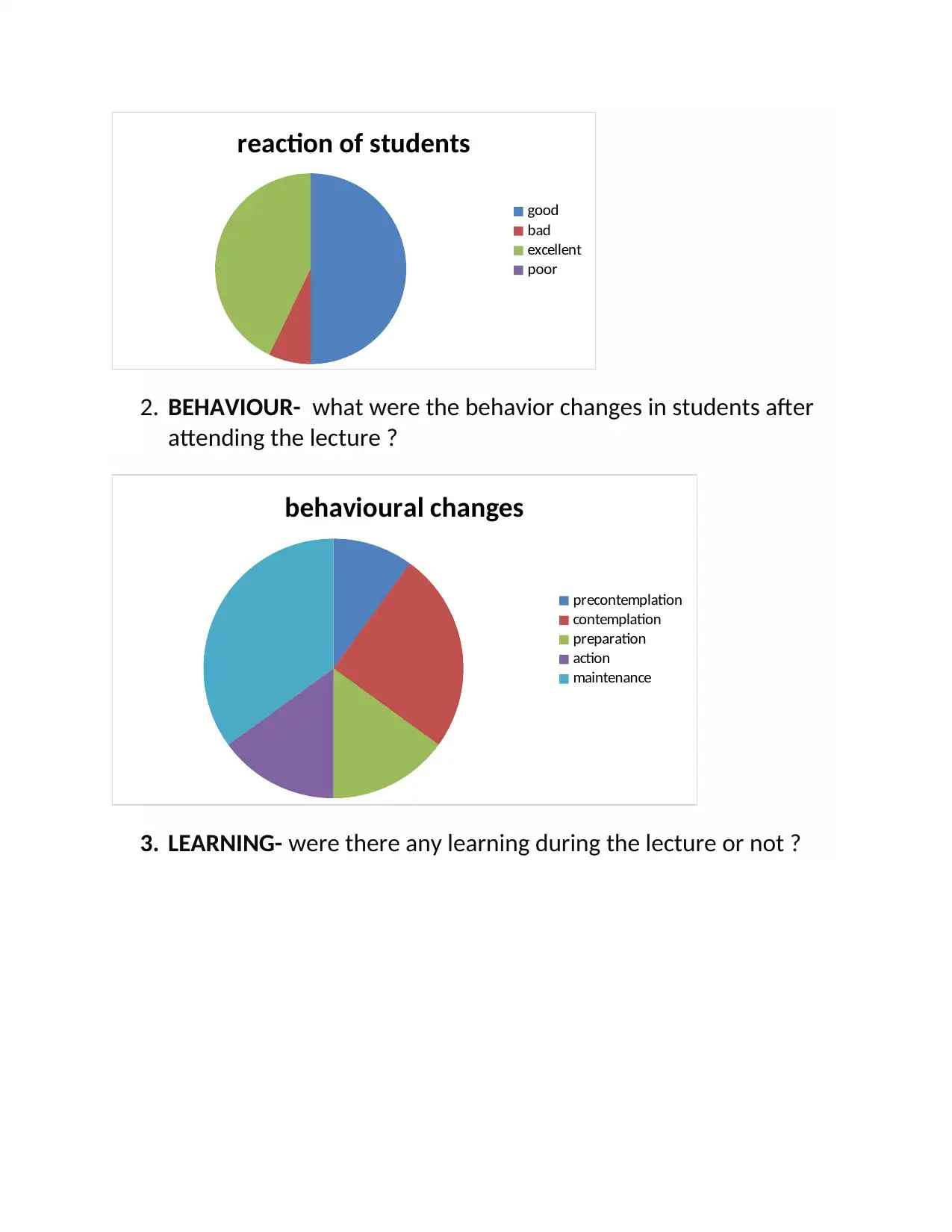
reaction of students
good
bad
excellent
poor
2. BEHAVIOUR- what were the behavior changes in students after
attending the lecture ?
behavioural changes
precontemplation
contemplation
preparation
action
maintenance
3. LEARNING- were there any learning during the lecture or not ?
good
bad
excellent
poor
2. BEHAVIOUR- what were the behavior changes in students after
attending the lecture ?
behavioural changes
precontemplation
contemplation
preparation
action
maintenance
3. LEARNING- were there any learning during the lecture or not ?
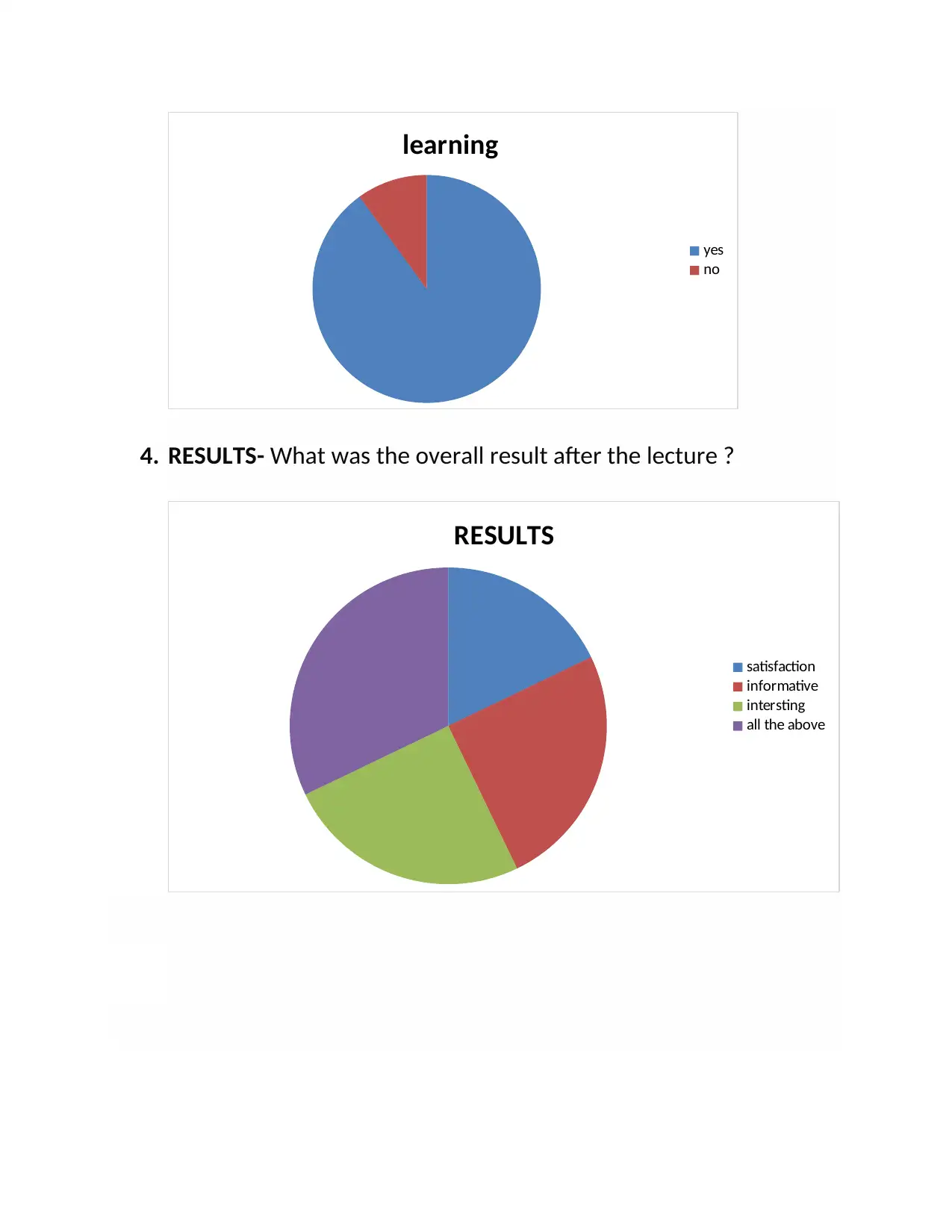
learning
yes
no
4. RESULTS- What was the overall result after the lecture ?
RESULTS
satisfaction
informative
intersting
all the above
yes
no
4. RESULTS- What was the overall result after the lecture ?
RESULTS
satisfaction
informative
intersting
all the above
Paraphrase This Document
Need a fresh take? Get an instant paraphrase of this document with our AI Paraphraser
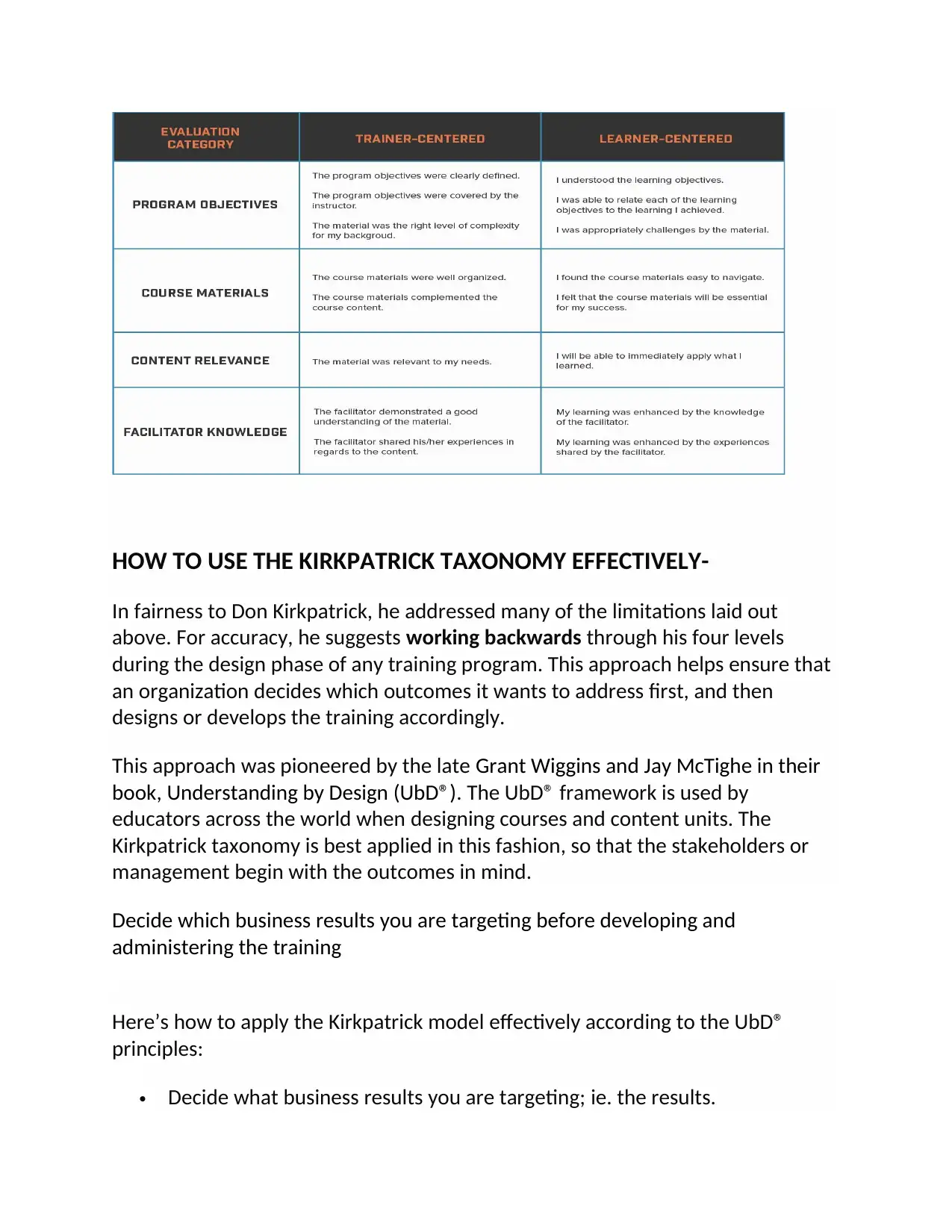
HOW TO USE THE KIRKPATRICK TAXONOMY EFFECTIVELY-
In fairness to Don Kirkpatrick, he addressed many of the limitations laid out
above. For accuracy, he suggests working backwards through his four levels
during the design phase of any training program. This approach helps ensure that
an organization decides which outcomes it wants to address first, and then
designs or develops the training accordingly.
This approach was pioneered by the late Grant Wiggins and Jay McTighe in their
book, Understanding by Design (UbD®). The UbD® framework is used by
educators across the world when designing courses and content units. The
Kirkpatrick taxonomy is best applied in this fashion, so that the stakeholders or
management begin with the outcomes in mind.
Decide which business results you are targeting before developing and
administering the training
Here’s how to apply the Kirkpatrick model effectively according to the UbD®
principles:
Decide what business results you are targeting; ie. the results.
In fairness to Don Kirkpatrick, he addressed many of the limitations laid out
above. For accuracy, he suggests working backwards through his four levels
during the design phase of any training program. This approach helps ensure that
an organization decides which outcomes it wants to address first, and then
designs or develops the training accordingly.
This approach was pioneered by the late Grant Wiggins and Jay McTighe in their
book, Understanding by Design (UbD®). The UbD® framework is used by
educators across the world when designing courses and content units. The
Kirkpatrick taxonomy is best applied in this fashion, so that the stakeholders or
management begin with the outcomes in mind.
Decide which business results you are targeting before developing and
administering the training
Here’s how to apply the Kirkpatrick model effectively according to the UbD®
principles:
Decide what business results you are targeting; ie. the results.
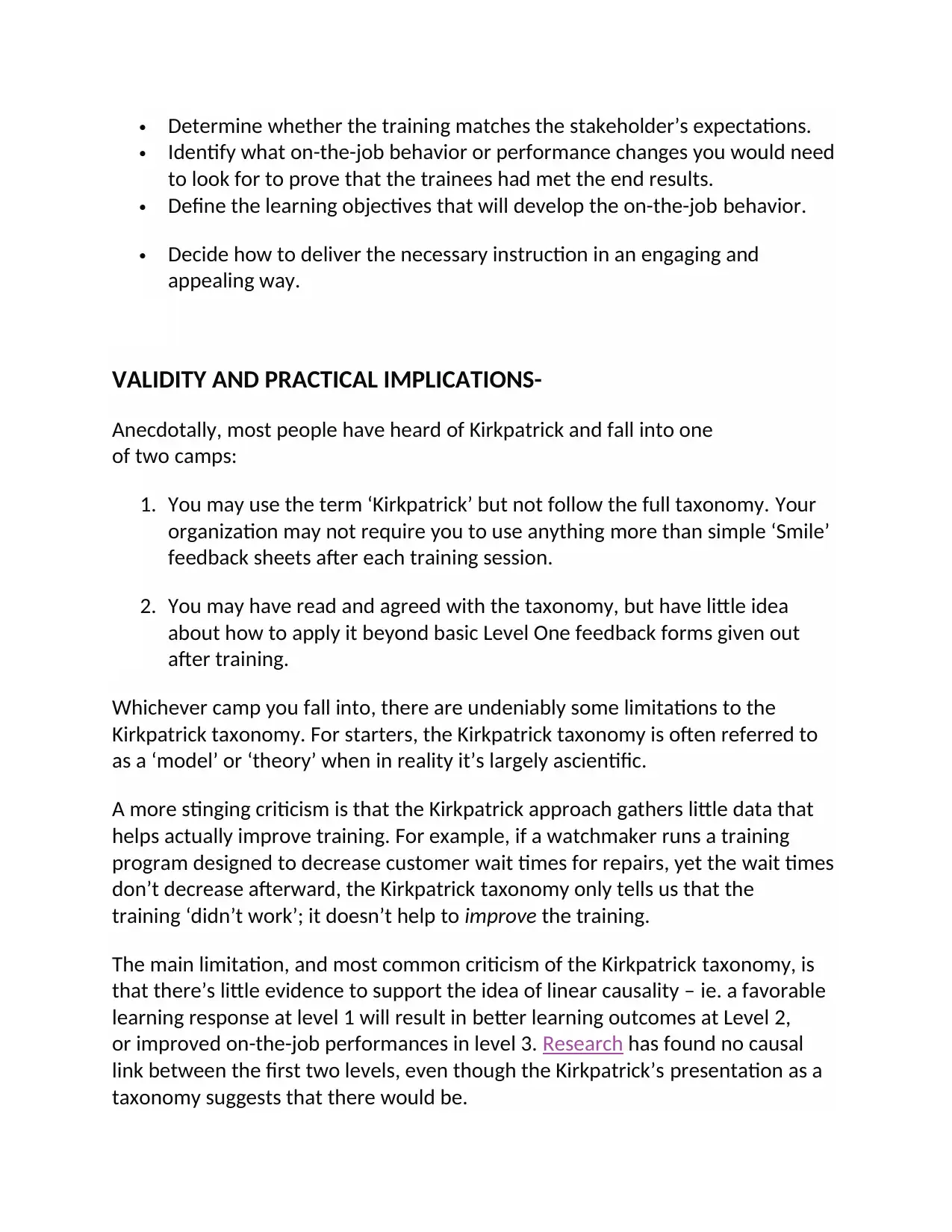
Determine whether the training matches the stakeholder’s expectations.
Identify what on-the-job behavior or performance changes you would need
to look for to prove that the trainees had met the end results.
Define the learning objectives that will develop the on-the-job behavior.
Decide how to deliver the necessary instruction in an engaging and
appealing way.
VALIDITY AND PRACTICAL IMPLICATIONS-
Anecdotally, most people have heard of Kirkpatrick and fall into one
of two camps:
1. You may use the term ‘Kirkpatrick’ but not follow the full taxonomy. Your
organization may not require you to use anything more than simple ‘Smile’
feedback sheets after each training session.
2. You may have read and agreed with the taxonomy, but have little idea
about how to apply it beyond basic Level One feedback forms given out
after training.
Whichever camp you fall into, there are undeniably some limitations to the
Kirkpatrick taxonomy. For starters, the Kirkpatrick taxonomy is often referred to
as a ‘model’ or ‘theory’ when in reality it’s largely ascientific.
A more stinging criticism is that the Kirkpatrick approach gathers little data that
helps actually improve training. For example, if a watchmaker runs a training
program designed to decrease customer wait times for repairs, yet the wait times
don’t decrease afterward, the Kirkpatrick taxonomy only tells us that the
training ‘didn’t work’; it doesn’t help to improve the training.
The main limitation, and most common criticism of the Kirkpatrick taxonomy, is
that there’s little evidence to support the idea of linear causality – ie. a favorable
learning response at level 1 will result in better learning outcomes at Level 2,
or improved on-the-job performances in level 3. Research has found no causal
link between the first two levels, even though the Kirkpatrick’s presentation as a
taxonomy suggests that there would be.
Identify what on-the-job behavior or performance changes you would need
to look for to prove that the trainees had met the end results.
Define the learning objectives that will develop the on-the-job behavior.
Decide how to deliver the necessary instruction in an engaging and
appealing way.
VALIDITY AND PRACTICAL IMPLICATIONS-
Anecdotally, most people have heard of Kirkpatrick and fall into one
of two camps:
1. You may use the term ‘Kirkpatrick’ but not follow the full taxonomy. Your
organization may not require you to use anything more than simple ‘Smile’
feedback sheets after each training session.
2. You may have read and agreed with the taxonomy, but have little idea
about how to apply it beyond basic Level One feedback forms given out
after training.
Whichever camp you fall into, there are undeniably some limitations to the
Kirkpatrick taxonomy. For starters, the Kirkpatrick taxonomy is often referred to
as a ‘model’ or ‘theory’ when in reality it’s largely ascientific.
A more stinging criticism is that the Kirkpatrick approach gathers little data that
helps actually improve training. For example, if a watchmaker runs a training
program designed to decrease customer wait times for repairs, yet the wait times
don’t decrease afterward, the Kirkpatrick taxonomy only tells us that the
training ‘didn’t work’; it doesn’t help to improve the training.
The main limitation, and most common criticism of the Kirkpatrick taxonomy, is
that there’s little evidence to support the idea of linear causality – ie. a favorable
learning response at level 1 will result in better learning outcomes at Level 2,
or improved on-the-job performances in level 3. Research has found no causal
link between the first two levels, even though the Kirkpatrick’s presentation as a
taxonomy suggests that there would be.

The fourth main limitation of the Kirkpatrick model is that it measures learning in
terms of return on stakeholder expectations (ROE). Some firms are looking for a
traditional return on investment evaluation where the cost of the training is set
against the benefits that it delivered for the company.
terms of return on stakeholder expectations (ROE). Some firms are looking for a
traditional return on investment evaluation where the cost of the training is set
against the benefits that it delivered for the company.
1 out of 10
Related Documents
Your All-in-One AI-Powered Toolkit for Academic Success.
+13062052269
info@desklib.com
Available 24*7 on WhatsApp / Email
![[object Object]](/_next/static/media/star-bottom.7253800d.svg)
Unlock your academic potential
© 2024 | Zucol Services PVT LTD | All rights reserved.





